that 和where区别
定语从句 that which who的区别

5、关系代词that和which的区别(1)相同点这两个关系代词引导定语从句时,都可以指物;在从句中都可作主语或宾语;作宾语时都可省略。
The train that ( which ) has just left is for Shanghai.刚开的那列火车是去上海的。
(作主语)The film that(which) we saw last night is wonderful.我们昨天晚上看的电影好极了。
(作宾语,可省略) (2)用that,不用which的情况①当先行词是不定代词或被它们修饰时。
all, everything, nothing, something, anything, little等不定代词时(something之后也可用which)。
To get the job started, all that I need is your permission.要开始工作,我所需要的是你的许可。
Is there anything that I can do for you?有什么要我做的事吗?He answered few questions that the teacher asked.他几乎没有回答老师的那些问题。
②当先行词被形容词最高级或序数词修饰时。
This was one of the most interesting books that were sold in this book store.这是这家书店售出的最有趣的书之一。
The first thing that should be done is to get some food.该做的第一件事是弄点吃的。
③当先行词有the very,the only,the same等修饰时。
That’s the only thing that we can do now.目前我们只能这样了。
Those are the very words that he used.那就是他的原话。
定语从句的引导词及其用法总结
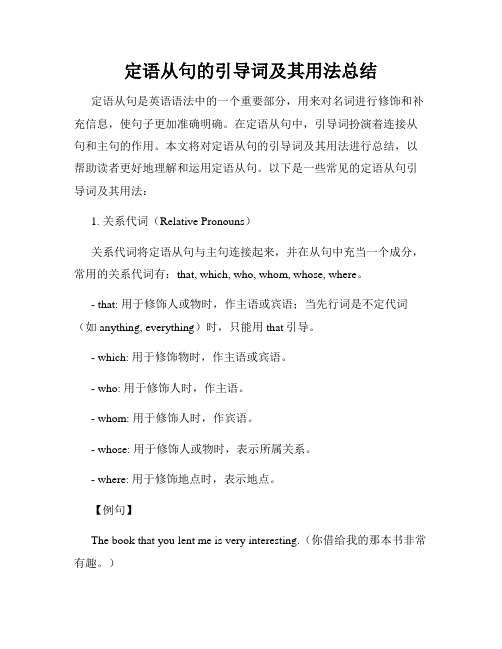
定语从句的引导词及其用法总结定语从句是英语语法中的一个重要部分,用来对名词进行修饰和补充信息,使句子更加准确明确。
在定语从句中,引导词扮演着连接从句和主句的作用。
本文将对定语从句的引导词及其用法进行总结,以帮助读者更好地理解和运用定语从句。
以下是一些常见的定语从句引导词及其用法:1. 关系代词(Relative Pronouns)关系代词将定语从句与主句连接起来,并在从句中充当一个成分,常用的关系代词有:that, which, who, whom, whose, where。
- that: 用于修饰人或物时,作主语或宾语;当先行词是不定代词(如anything, everything)时,只能用that引导。
- which: 用于修饰物时,作主语或宾语。
- who: 用于修饰人时,作主语。
- whom: 用于修饰人时,作宾语。
- whose: 用于修饰人或物时,表示所属关系。
- where: 用于修饰地点时,表示地点。
【例句】The book that you lent me is very interesting.(你借给我的那本书非常有趣。
)This is the house where I used to live.(这是我曾经住过的房子。
)2. 关系副词(Relative Adverbs)关系副词在从句中充当状语,并连接定语从句和主句。
常用的关系副词有:when, where, why。
- when: 用于修饰时间时,表示时间。
- where: 用于修饰地点时,表示地点。
- why: 用于修饰原因时,表示原因。
【例句】I will never forget the day when we first met.(我永远不会忘记我们第一次见面的那天。
)That is the reason why he was late.(那就是他迟到的原因。
)3. 关系代词与关系副词的区别关系代词用来引导定语从句并在从句中充当成分,而关系副词只充当状语。
如何区别定语从句的关系词是使用that还是where
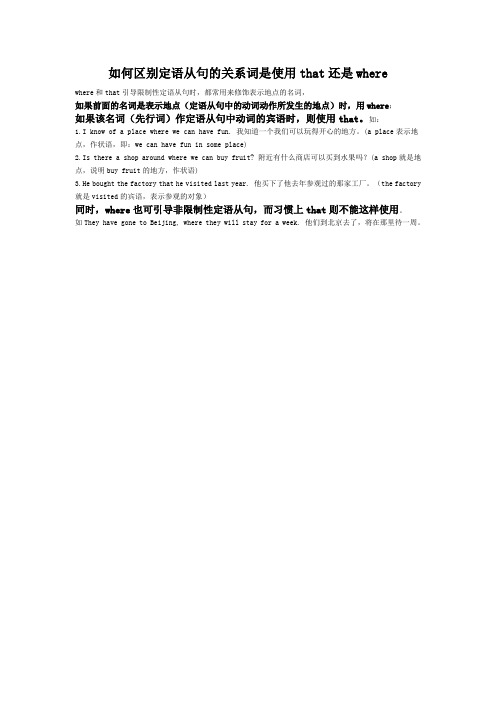
如何区别定语从句的关系词是使用that还是where
where和that引导限制性定语从句时,都常用来修饰表示地点的名词,
如果前面的名词是表示地点(定语从句中的动词动作所发生的地点)时,用where;
如果该名词(先行词)作定语从句中动词的宾语时,则使用that。
如:
1.I know of a place where we can have fun. 我知道一个我们可以玩得开心的地方。
(a place表示地点,作状语,即:we can have fun in some place)
2.Is there a shop around where we can buy fruit? 附近有什么商店可以买到水果吗?(a shop就是地点,说明buy fruit的地方,作状语)
3.He bought the factory that he visited last year. 他买下了他去年参观过的那家工厂。
(the factory 就是visited的宾语,表示参观的对象)
同时,where也可引导非限制性定语从句,而习惯上that则不能这样使用。
如They have gone to Beijing, where they will stay for a week. 他们到北京去了,将在那里待一周。
关系代词和关系副词怎么区分使用

区别是:关系副词在定语从句中做状语,关系代词在定语从句中做主语后者宾语。
他们和关系代词主要的区别是where,when,why=介词+which。
1、关系代词(that, who, whom, whose, which)所代替的先行词是人或物的名词或代词,并在句中充当主语、宾语、定语等成分。
例一、Is he the man who/that wants to see you?(who / that在从句中作主语,指人)例二、He is the man whom/ that I saw yesterday.(whom / that 在从句中作宾语,指人)例三、They rushed over to help the man whose car had broken down.(whose在句中作定语,指人)例四、Please pass me the book whose cover is green.(whose 在句中作定语,指物。
)2、关系副词(when, where, why,)可代替的先行词是时间、地点或原因的名词,在从句中作状语。
关系副词when, where,why的含义相当于"介词+ which"结构,因此常常和"介词+ which"结构交替使用。
例五、Beijing is the place where (in which) I was born.例六、Is this the reason why (for which) he refused our offer?例七、His father died the year (when / in which) he was born.例八、He can’t find the place (where / in which) he lived forty years ago.二丶判断用关系代词和关系副词用关系代词,还是关系副词完全取决于从句中的谓语动词。
定语从句wherethatwhich区别
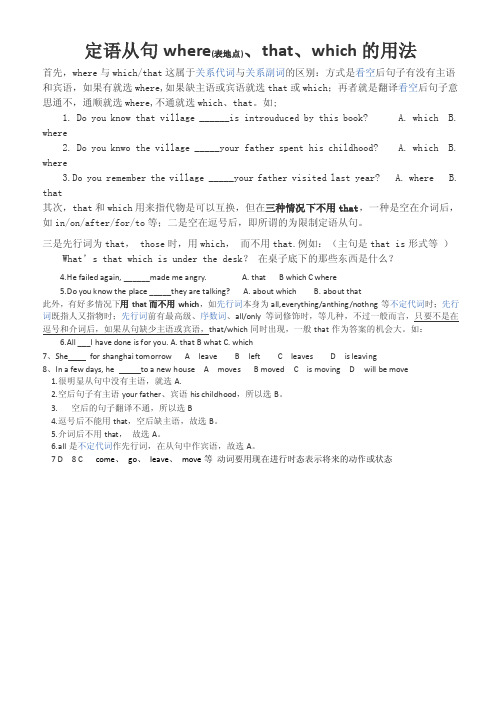
定语从句where(表地点)、that、which的用法首先,where与which/that这属于关系代词与关系副词的区别:方式是看空后句子有没有主语和宾语,如果有就选where,如果缺主语或宾语就选that或which;再者就是翻译看空后句子意思通不,通顺就选where,不通就选which、that。
如;1. Do you know that village ______is introuduced by this book? A. which B. where2. Do you knwo the village _____your father spent his childhood? A. which B. where3.Do you remember the village _____your father visited last year? A. where B. that其次,that和which用来指代物是可以互换,但在三种情况下不用that,一种是空在介词后,如in/on/after/for/to等;二是空在逗号后,即所谓的为限制定语从句。
三是先行词为that, those时,用which,而不用that.例如:(主句是that is形式等) What’s that which is under the desk?在桌子底下的那些东西是什么?4.He failed again, ______made me angry. A. that B which C where5.Do you know the place _____they are talking? A. about which B. about that此外,有好多情况下用that而不用which,如先行词本身为all,everything/anthing/nothng等不定代词时;先行词既指人又指物时;先行词前有最高级、序数词、all/only等词修饰时,等几种,不过一般而言,只要不是在逗号和介词后,如果从句缺少主语或宾语,that/which同时出现,一般that作为答案的机会大。
定语从句中who与that,that与which的区别
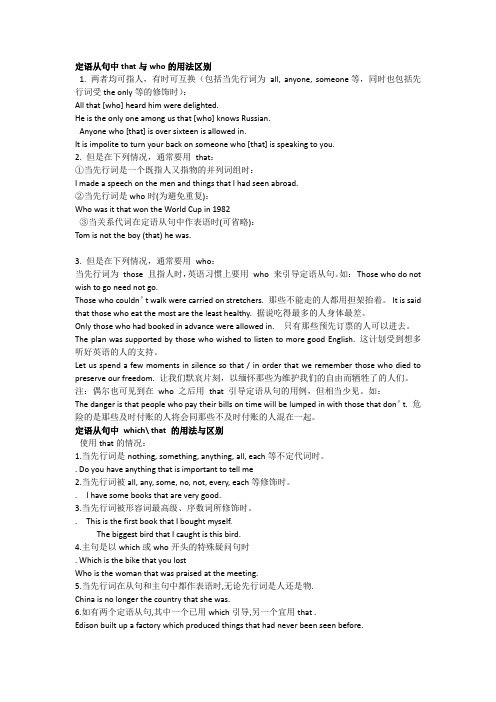
定语从句中that与who的用法区别1. 两者均可指人,有时可互换(包括当先行词为all, anyone, someone等,同时也包括先行词受the only等的修饰时):All that [who] heard him were delighted.He is the only one among us that [who] knows Russian.Anyone who [that] is over sixteen is allowed in.It is impolite to turn your back on someone who [that] is speaking to you.2. 但是在下列情况,通常要用that:①当先行词是一个既指人又指物的并列词组时:I made a speech on the men and things that I had seen abroad.②当先行词是who时(为避免重复):Who was it that won the World Cup in 1982③当关系代词在定语从句中作表语时(可省略):Tom is not the boy (that) he was.3. 但是在下列情况,通常要用who:当先行词为those 且指人时,英语习惯上要用who 来引导定语从句。
如:Those who do not wish to go need not go.Those who couldn’t walk were carried on stretchers. 那些不能走的人都用担架抬着。
It is said that those who eat the most are the least healthy. 据说吃得最多的人身体最差。
Only those who had booked in advance were allowed in. 只有那些预先订票的人可以进去。
that从句的用法总结

that从句的用法总结一、什么是that从句在英语中,that从句是一种引导词从句的类型。
它以关系代词"that"来引导一个独立的从句,该从句对前面的名词或动词起到补充和解释的作用。
相比于其他引导词如who, which, where等,that从句常用于强调事实和陈述性的内容。
1. 用作主语That从句可以作为整个主语,用来说明整个主旨。
例:That she is talented is known to all.这里,“That she is talented” 是整个主语。
2. 用作宾语That从句也经常被用作及物动词或介词后面的宾语。
例:He emphasized that we should study harder.这里,“that we should study harder” 是动词 "emphasized" 的宾语。
3. 用作表语That从句有时也可以被用作系动词后面的表语。
例:The truth is that he lied to us.这里,“that he lied to us” 就是名词 "truth" 的表语。
二、that从句的结构和使用方法1. 声明陈述观点我们可以使用that从句来声明观点、提供信息或者传达消息。
例:I believe that honesty is the best policy.这里,“that honesty is the best policy” 是一个 that从句,用于表达主观的观点和信念。
2. 引导间接引语当我们间接引述他人的话语时,that从句通常用来引导并嵌套在一般陈述中。
例:She told me that she was tired.这里,“that she was tired” 是一个 that从句,表示她告诉我她很累。
3. 解释原因That从句也可以用来解释某种结果或原因。
:what,that,where ,who ,how在不同从句中的用法
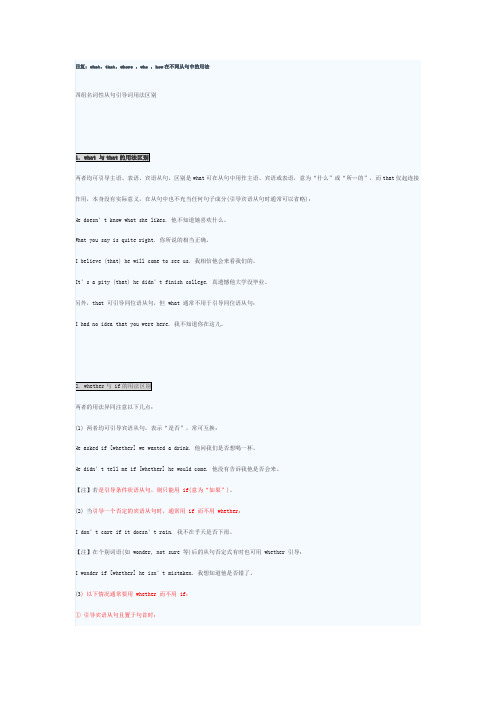
Whether he has left, I can’t say. 他是否走了,我说不定。
②引导主语从句且放在句首时:Whether he will come is still a question. 他是否会来还是个问题。
【注】若在句首使用形式主语 it,而将主语从句放在句末,则有时也可用 if 来引导:It was not known whether [if] he would come. 不知他是否会来。
③ 引导表语从句时:The question is whether we should go on with the work. 问题是我们是否应该继续进行这项工作。
【注】在很不正式的场合if偶尔也用于引导表语从句,但远不如用 whether 常见。
④ 引导让步状语从句时:Whether he agrees or not, I shall do that. 不管他同意与否,我都要那样做。
⑤ 引导同位语从句时:The question whether we need it has not been considered. 我们是否需要它还没有考虑。
⑥ 用于不定式之前时:I’m not sure whether to stay or leave. 我不知是留还是去。
I didn’t know whether to laugh or to cry. 我真是哭笑不得。
⑦用于介词之后时:It depends on whether the letter arrives in time. 这取决于信是否来得及时。
I worry about whether I hurt her feelings. 我担心是否伤了她的感情。
⑧直接与 or not 连用时:I will write to you whether or not I can come. 我能不能来,我将写信告诉你。
【注】若不是直接与 or not 用在一起,则有时也可用 if:I don’t know whether [if] he will win or not. 我不知他是否能赢。
定语从句中引导词where,what,whom,whose,that,who的用法
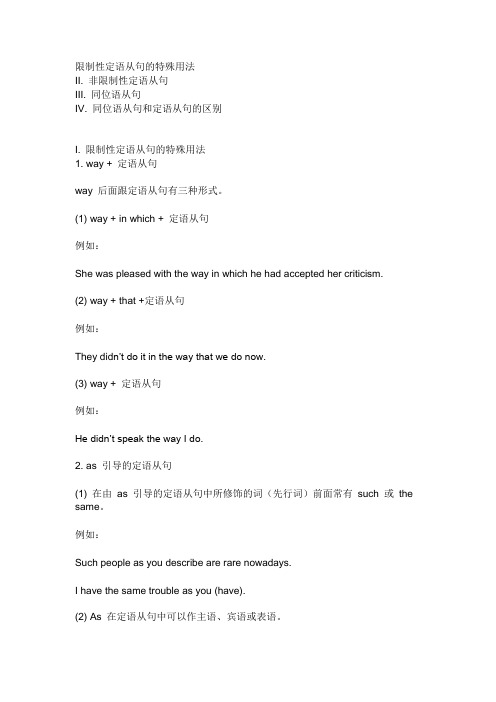
限制性定语从句的特殊用法II. 非限制性定语从句III. 同位语从句IV. 同位语从句和定语从句的区别I. 限制性定语从句的特殊用法1. way + 定语从句way 后面跟定语从句有三种形式。
(1) way + in which + 定语从句例如:She was pleased with the way in which he had accepted her criticism.(2) way + that +定语从句例如:They did n’t do it in the way that we do now.(3) way + 定语从句例如:He didn’t speak the way I do.2. as 引导的定语从句(1) 在由as 引导的定语从句中所修饰的词(先行词)前面常有such 或the same。
例如:Such people as you describe are rare nowadays.I have the same trouble as you (have).(2) As 在定语从句中可以作主语、宾语或表语。
例如:Let’s discuss only such questions as concern everyone of us.(作主语)I never heard such stories as he tells.(作宾语)I’ve never seen such a clever man as he is.(作表语)(3) As 有时引导非限制性定语从句,可在定语从句中作主语、宾语、表语,修饰主句,常解释为正如、如同。
例如:As is known to all, the earth moves round the sun.(作主语)As was expected, he performed the task with success.(作主语)As he predicted, the wind changed.(作宾语)The meeting is very important, as indeed it is.(作表语)II. 非限制性定语从句1.非限制性定语从句由who, whom, which 引导(不可用that),还可以由whose, when, where 等词引导。
wherewhich的用法
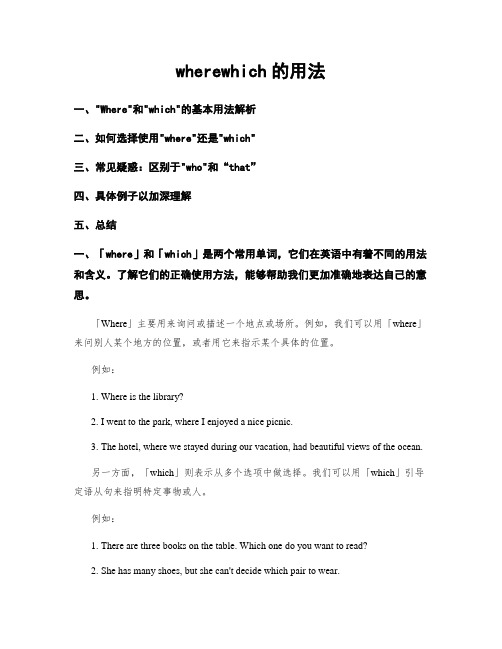
wherewhich的用法一、"Where"和"which"的基本用法解析二、如何选择使用"where"还是"which"三、常见疑惑:区别于"who"和“that”四、具体例子以加深理解五、总结一、「where」和「which」是两个常用单词,它们在英语中有着不同的用法和含义。
了解它们的正确使用方法,能够帮助我们更加准确地表达自己的意思。
「Where」主要用来询问或描述一个地点或场所。
例如,我们可以用「where」来问别人某个地方的位置,或者用它来指示某个具体的位置。
例如:1. Where is the library?2. I went to the park, where I enjoyed a nice picnic.3. The hotel, where we stayed during our vacation, had beautiful views of the ocean.另一方面,「which」则表示从多个选项中做选择。
我们可以用「which」引导定语从句来指明特定事物或人。
例如:1. There are three books on the table. Which one do you want to read?2. She has many shoes, but she can't decide which pair to wear.3. The blue car, which was parked outside, caught my attention.二、在选择使用「where」还是「which」时,请根据上下文以及你要传达的意思进行判断。
如果你需要询问或描述一个地点或场所,那么应该使用「where」。
例如,你想问一个地方的位置或者描述某处的特征时,使用「where」是非常恰当的。
who,whom,whose,that,which
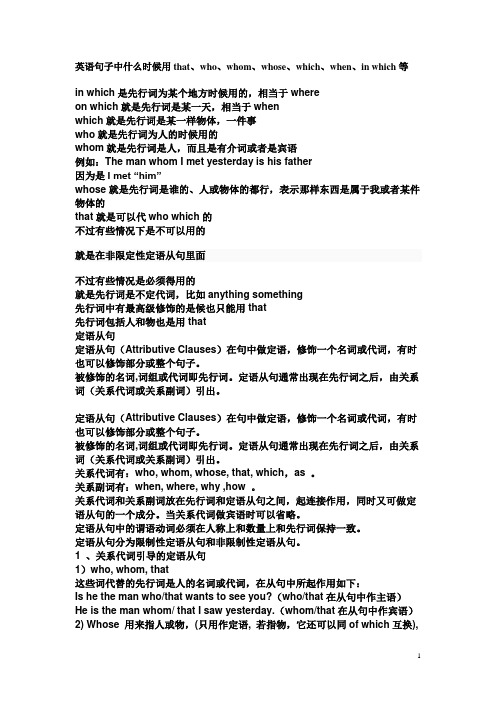
英语句子中什么时候用that、who、whom、whose、which、when、in which等in which是先行词为某个地方时候用的,相当于whereon which就是先行词是某一天,相当于whenwhich就是先行词是某一样物体,一件事who就是先行词为人的时候用的whom就是先行词是人,而且是有介词或者是宾语例如:The man whom I met yesterday is his father因为是I met “him”whose就是先行词是谁的、人或物体的都行,表示那样东西是属于我或者某件物体的that就是可以代who which的不过有些情况下是不可以用的就是在非限定性定语从句里面不过有些情况是必须得用的就是先行词是不定代词,比如anything something先行词中有最高级修饰的是候也只能用that先行词包括人和物也是用that定语从句定语从句(Attributive Clauses)在句中做定语,修饰一个名词或代词,有时也可以修饰部分或整个句子。
被修饰的名词,词组或代词即先行词。
定语从句通常出现在先行词之后,由关系词(关系代词或关系副词)引出。
定语从句(Attributive Clauses)在句中做定语,修饰一个名词或代词,有时也可以修饰部分或整个句子。
被修饰的名词,词组或代词即先行词。
定语从句通常出现在先行词之后,由关系词(关系代词或关系副词)引出。
关系代词有:who, whom, whose, that, which,as 。
关系副词有:when, where, why ,how 。
关系代词和关系副词放在先行词和定语从句之间,起连接作用,同时又可做定语从句的一个成分。
当关系代词做宾语时可以省略。
定语从句中的谓语动词必须在人称上和数量上和先行词保持一致。
定语从句分为限制性定语从句和非限制性定语从句。
1 、关系代词引导的定语从句1)who, whom, that这些词代替的先行词是人的名词或代词,在从句中所起作用如下:Is he the man who/that wants to see you?(who/that在从句中作主语)He is the man whom/ that I saw yesterday.(whom/that在从句中作宾语)2) Whose 用来指人或物,(只用作定语, 若指物,它还可以同of which互换),例如:They rushed over to help the man whose car had broken down.Please pass me the book whose (of which) cover is green.3)which, that它们所代替的先行词是事物的名词或代词,在从句中可作主语、宾语等,例如:A prosperity繁荣which / that had never been seen before appears in the countryside.(which / that在句中作宾语)The package (which / that) you are carrying is about to come unwrapped. (which / that在句中作宾语)关系代词that和which 都可以指物,that 和Who 都可以指人,其用法区别:1)不用that的情况a) 在引导非限定性定语从句时(错) The tree, that is four hundred years old, is very famous here.b) 介词后不能用We depend on the land from which we get our food.c)多用who 的情况①关系代词在从句中做主语A friend who helps you in time of need is a real friend .②先行词为those , people 时Those who were either fools or unfit for their offices could not see the true .③先行词为all, anyone , ones , one 指人时One who doesn’t work hard will never succeed in his work .④在There be句型中There is a stranger who wants to see you .⑤在被分隔的定语从句中A new teacher will come tomorrow who will teach you German .⑥在有两个定语从句的句子中,其一用who,其二用that,但若先行词后接两个以上的并列定语从句时,后一个必须重复前一个关系代词。
定语从句中that和where的区别
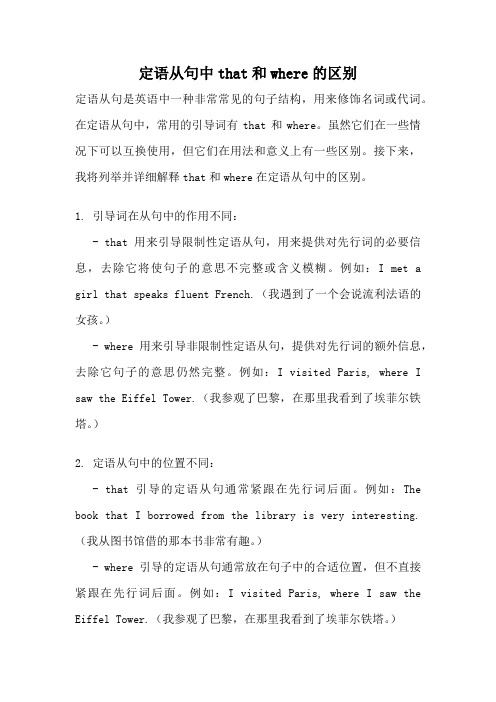
定语从句中that和where的区别定语从句是英语中一种非常常见的句子结构,用来修饰名词或代词。
在定语从句中,常用的引导词有that和where。
虽然它们在一些情况下可以互换使用,但它们在用法和意义上有一些区别。
接下来,我将列举并详细解释that和where在定语从句中的区别。
1. 引导词在从句中的作用不同:- that用来引导限制性定语从句,用来提供对先行词的必要信息,去除它将使句子的意思不完整或含义模糊。
例如:I met a girl that speaks fluent French.(我遇到了一个会说流利法语的女孩。
)- where用来引导非限制性定语从句,提供对先行词的额外信息,去除它句子的意思仍然完整。
例如:I visited Paris, where I saw the Eiffel Tower.(我参观了巴黎,在那里我看到了埃菲尔铁塔。
)2. 定语从句中的位置不同:- that引导的定语从句通常紧跟在先行词后面。
例如:The book that I borrowed from the library is very interesting.(我从图书馆借的那本书非常有趣。
)- where引导的定语从句通常放在句子中的合适位置,但不直接紧跟在先行词后面。
例如:I visited Paris, where I saw the Eiffel Tower.(我参观了巴黎,在那里我看到了埃菲尔铁塔。
)3. 先行词的不同:- that引导的定语从句通常修饰具体的人或物,可以是指示代词、名词或代词。
例如:The car that I bought last week is red.(我上周买的那辆车是红色的。
)- where引导的定语从句通常修饰地点或场所。
例如:I visited Paris, where I saw the Eiffel Tower.(我参观了巴黎,在那里我看到了埃菲尔铁塔。
定语从句中that, which, what的区别

非限制性定语从句举例:
(1) His mother, who loves him very much, is strict with him.
(2) China, which was founded in 1949, is becoming more and more powerful.
3.“介词+关系代词”前可有some, any, none, both, all, neither, most, each, few等代词或者数词
(1) He loved his parents deeply, both of whom are very kind to him.
(2) In the basket there are quite many apples, some of which have gone bad.
他的哥哥是当医生的,常鼓励他要考上大学。(他只有一个哥哥)
难点分析
(一)限制性定语从句只能用that 的几种情况
1.当先行词是anything, everything, nothing (something 除外), few, all, none, little,
some 等代词时,或者是由every, any, all, some, no, little, few, much 等修饰时
(2) This is the watch for which I am looking. (F)
2. 若介词放在关系代词前,关系代词指人时用whom,不可用who或者that;指物时用which,不能用that;关系代词是所有格时用whose
that的用法和搭配规则

that的用法和搭配规则一、引言"That"是一个常用的英语单词,用法和搭配规则非常多样化。
在本文中,我们将深入探讨"That"的使用方法,以帮助读者更好地理解和运用它。
二、作为指示代词的用法1. 指示远处的人或物:例如,“That car over there is mine.”(那辆车就是我的。
)2. 强调某人或某物:例如,“I want that book, not this one.”(我想要那本书,不是这本。
)3. 在问答句中询问对方是否同意或了解:例如,“Is that what you meant?”(你是这个意思吗?)三、作为连词的用法1. 引导宾语从句:例如,“She said that she would come later.”(她说她会晚点来。
)2. 引导结果从句:例如,“I am so tired that I can't walk anymore.”(我太累了,无法再走下去。
)3. 与such连用构成固定短语:例如,“It's such a beautiful day that we should go for a walk.”(天气太好了,我们应该去散散步。
)四、作为代词的用法1. 代替前面提到过的特定人或物:例如,“Where is the book? Give me that.”(书在哪里?给我那本。
)2. 代替整个句子或前后文的内容:例如,“I can't believe that he said such a thing.”(我无法相信他说了那样的话。
)五、作为形容词的用法1. 表示特定的人或物:例如,“That car is expensive.”(那辆车很贵。
)2. 强调某人或某物:例如,“I want that book, not this one.”(我想要那本书,不是这本。
)六、作为副词的用法1. 强调程度:例如,“Why did you eat all of that cake?”(你为什么把那个蛋糕都吃完了?)2. 引起读者对之前提到内容的注意:例如,“She is a talented pianist. Did you know that?”(她是个有才华的钢琴家,你知道吗?)七、习惯搭配规则1. 注意与“such”和“so”的区别:在强调程度时使用“such”和“so”,而不是单独使用“That”。
定语从句中的连接代词与连接副词
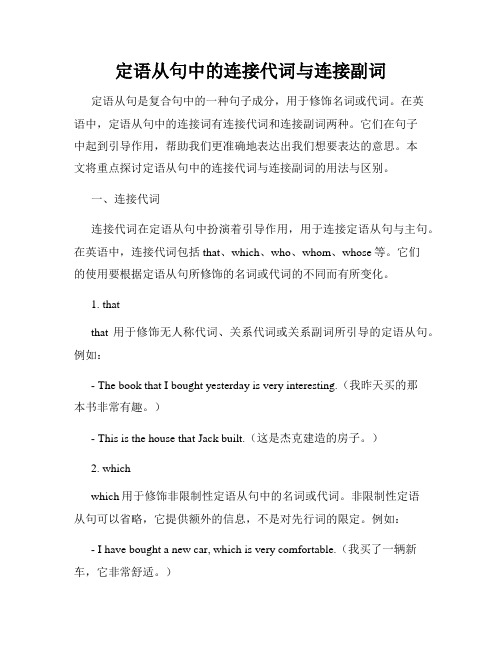
定语从句中的连接代词与连接副词定语从句是复合句中的一种句子成分,用于修饰名词或代词。
在英语中,定语从句中的连接词有连接代词和连接副词两种。
它们在句子中起到引导作用,帮助我们更准确地表达出我们想要表达的意思。
本文将重点探讨定语从句中的连接代词与连接副词的用法与区别。
一、连接代词连接代词在定语从句中扮演着引导作用,用于连接定语从句与主句。
在英语中,连接代词包括that、which、who、whom、whose等。
它们的使用要根据定语从句所修饰的名词或代词的不同而有所变化。
1. thatthat用于修饰无人称代词、关系代词或关系副词所引导的定语从句。
例如:- The book that I bought yesterday is very interesting.(我昨天买的那本书非常有趣。
)- This is the house that Jack built.(这是杰克建造的房子。
)2. whichwhich用于修饰非限制性定语从句中的名词或代词。
非限制性定语从句可以省略,它提供额外的信息,不是对先行词的限定。
例如:- I have bought a new car, which is very comfortable.(我买了一辆新车,它非常舒适。
)3. who/whomwho用于修饰人,作为主语或宾语出现在定语从句中。
whom只能作为宾语出现。
例如:- The man who is sitting over there is my uncle.(那个坐在那边的人是我的叔叔。
)- She invited the girl whom she met yesterday.(她邀请了她昨天遇到的那个女孩。
)4. whosewhose用于修饰物或人,表示所属关系。
例如:- This is the house whose owner is a famous actor.(这是房主是一位著名演员的房子。
)二、连接副词连接副词在定语从句中充当连接的角色,与连接代词类似,用于连接定语从句与主句。
which,where,that 在定语从句中的区别

In English grammar, "which," "where," and "that" are all used in defining or non-defining relative clauses to connect a dependent clause to an independent clause. However, there are distinct differences in their usage and function.1. Which: "Which" is used to refer to a noun in the independent clause. It is typically used when the noun is a choice or option among multiple possibilities. For example: "The book which I am reading is very interesting." (我正在读的那本书很有趣。
)2. Where: "Where" is used to refer to a place or location. It replaces the place where an action occurs in the independent clause. For example: "The place where I grew up was beautiful." (我成长的地方很美。
)3. That: "That" is a more flexible option and can be used in place of "which" or "where" depending on the context. It is often used when the noun being referred to is essential to the meaning of the sentence. For example: "The car that my father bought me is red." (我父亲给我买的那辆车是红色的。
英语语法从句引导词that和where
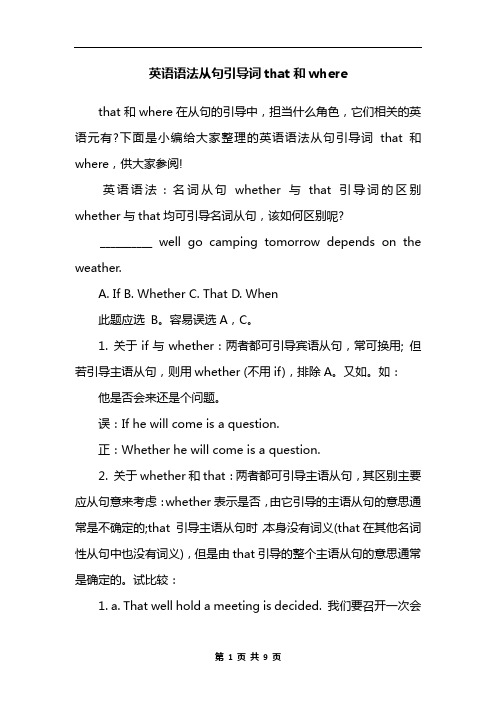
英语语法从句引导词that和wherethat和where在从句的引导中,担当什么角色,它们相关的英语元有?下面是小编给大家整理的英语语法从句引导词that和where,供大家参阅!英语语法:名词从句whether与that引导词的区别whether与that均可引导名词从句,该如何区别呢?__________ well go camping tomorrow depends on the weather.A. IfB. WhetherC. ThatD. When此题应选B。
容易误选A,C。
1. 关于if与whether:两者都可引导宾语从句,常可换用; 但若引导主语从句,则用whether (不用if),排除A。
又如。
如:他是否会来还是个问题。
误:If he will come is a question.正:Whether he will come is a question.2. 关于whether和that:两者都可引导主语从句,其区别主要应从句意来考虑:whether表示是否,由它引导的主语从句的意思通常是不确定的;that 引导主语从句时,本身没有词义(that在其他名词性从句中也没有词义),但是由that引导的整个主语从句的意思通常是确定的。
试比较:1. a. That well hold a meeting is decided. 我们要召开一次会议,这已决定了。
b. Whether well hold a meeting is not decided. 我们是否要开一个会,这还没有决定。
2. a. That he has left here is clear. 他已离开了这儿,这点很清楚。
b. Whether he has left here is not clear. 他是否已离开这儿,这还不清楚。
3. a. That he can finish it in two hours is clear. 他能在两小时内完成它,这是显然的。
that和where定语从句

that 和where定语从句that 和where定语从句的区别:1.看被定语从句所修饰的先行词(名词/代词)能不能直接和从句相连.如果可以直接和从句其他成分相连,无须补上介词,则用that/which;如果需要额外补上介词才能放在定语从句中,则用where.如:This is the city (which/that I stayed in last year).把先行词the city放入后面的定语从句,为:I stayed in (the city) last year.the city直接做介词in的宾语,所以用which/that.再如:This is the city (where I stayed last year).把先行词the city放入定语从句,需要补上介词in方可,即为:I stayed (in the city) last year.所以使用where或in which.2.看定语从句是缺少地点状语还是缺少主语/宾语/表语.如果缺少地点状语,用where;如果只缺少主语/宾语/表语,则用which/that.如:This is the city (which/that) I visited last year.从句I visited last year中,及物动词visited后面缺少一个宾语,所以用which/that;再如:This is the city (where) I lived last year.I lived last year中,缺少地点状语in the city,所以用where或in which其实上面两种方法是一样的,不知道楼主能不能看明白?如果对你有所帮助,请点击我回答下面的“选为满意回答”按钮,限定性定语从句意义:限定性定语从句对被修饰的先行词有限定制约作用,使该词的含义更具体,更明确。
限制性定语从句不能被省略,否则句意就不完整,例如I met some one who said he knows you.在引导限定性定语从句时,that有时相当于in which,at which,for which或on which(1)Attitudes towards daydreaming are changing in much the same way that(in which) attitudes towards night dreaming have changed. 人们对白日做梦的态度正在改变,这与人们对夜间做梦的看法的变化有非常相似之处。
- 1、下载文档前请自行甄别文档内容的完整性,平台不提供额外的编辑、内容补充、找答案等附加服务。
- 2、"仅部分预览"的文档,不可在线预览部分如存在完整性等问题,可反馈申请退款(可完整预览的文档不适用该条件!)。
- 3、如文档侵犯您的权益,请联系客服反馈,我们会尽快为您处理(人工客服工作时间:9:00-18:30)。
请看下面一道题:He likes living alone, and says that he wants to go and live in a place _________ nobody knows.
A. where
B. that
C. when
D. what
有的同学一看到place 是表示“地点”的名词,于是就毫不犹豫地选了A,但是错了,最佳答案应是B。
表示“地点”的名词后到底是用where 还是用where that 或which 来引导定语从句,原则上应注意以下两点:
一是看关系词的句法功能。
由于where 是关系副词,它在定语从句中用作状语,而that 和which 是关系代词,它们在定语从句中用作主语或宾语。
所以区别是关系副词还是关系代词的关键就是看定语从句是否缺主语或宾语,若缺主语或宾语则用关系代词,若不缺主语或宾语则用关系副词。
比较:
(1) This is the room ________
A. that
B. where
C. who
D. what
(2) This is the room _________I lived in ten years ago.
A. that
B. where
C. who
D. what
(3) This is the room _________I bought ten years ago.
A. that
B. where
C. who
D.what
(4) This is the room _________I visited ten years ago.
Athat B.where C.who D.what
(5) This is the room _________I was born ten years ago.
A.that
B.where
C.who
D.what 第(1)题选B,因为live 是不及物动词,它无需接宾语;第(2)题选A,因为虽然live 不及物,但live in 却是及物,它应有自己的宾语;第(3)(4)题也应选A,因为buy 和visit 均为及物动词,它们应有自己的和(5)应选B,因为be born 无需有自己的宾语。
二要看句意。
一般说来,句子是否缺宾语,主要是看定语从句中的动词是否为及物动词或带有介词等,但问题是有些动词既可用作及物动词,又可用作不及物动词,它是否需要带宾语则要视句意而定。
比较:This is the school where I studied five years ago. 这是我五年前读过书的学校。
(句中study 用作不及物动词,意为study “学习”或“读书”)This is the school that I studied five years ago. 这是我五年前研究过的那所学校。
(句中study 为及物动词,意为“研究”)
现在我们回到上面的试题来看一看,从理论上说,动词know 可用作及物和不及物动词,
也就是说它可以带宾语也可以不带宾语。
但根据本句的意思(“他喜欢一个人生活,并说他要去一个没有知道的地方”),know 应为及物动词,因为从语意上它要带place 作其宾语。
